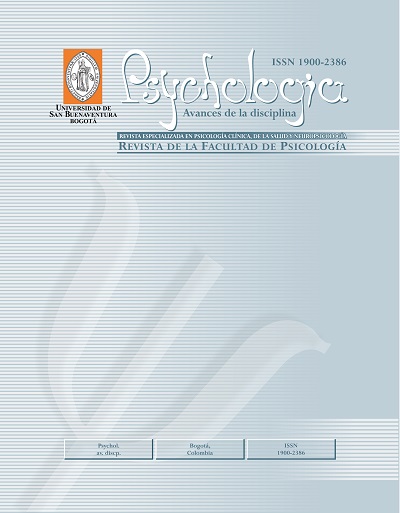View/Download
How to Cite
Reyes-Parra, P., Martinez, M. C. J., & Lara-Báez, C. (2017). Selective and sustained attention of workers of two different shifts in the day. Psychologia, 11(2), 113–120. https://doi.org/10.21500/19002386.3059
More Citation Formats
License terms
▼
This journal provides open, immediate access to its contents, based on the principle that offering the public free access to research helps to promote a higher global exchange of knowledge.
As such, all journal articles are published under a Creative Commons Attribution-NonCommercial-ShareAlike 4.0 International License (CC BY-NC-SA), by which commercial use of the original work or its possible derived works is not allowed, and the distribution thereof must be done with the same license elements regulating the original work.
http://creativecommons.org/licenses/by-nc-sa/4.0/
Abstract
Although the importance of the psychological process of attention and how it to contributes productive capacity and achieving efficient and effective results during the development of daily tasks has been recognized, it has not been sufficiently studied in workers of companies or organizations. This research sought to identify what selective and sustained attention is like in the workers to two different shifts in the day (morning and afternoon); Additional variables such as age, schooling and gender were investigated to see if they affected performance. We applied the computer program Vienna Test System sub-test cognitron form S1 to 184 university workers. Data was analyzed using a regression model and t-test for independent samples. The findings showed that selective attention is greater in the morning, while sustained attention is maintained throughout the day. As for the other variables analyzed, it was evidenced that age was the only predictor of performance, as workers of a younger age performed better. These results contribute to the planning of activities in the workplace and complements the studies in the area of the basic psychological processes.
References
Acevedo, A., Loewenstein, D. A., Barker, W. W., Harwood, D. G., Luis, C., Bravo, M., y Duara, R. (2000). Category fluency test: normative data for English-and Spanish-speaking elderly. Journal of the International Neuropsychological Society, 6(07), 760-769. doi: 10.1017/S1355617700677032
Adan, A. (1995). La cronopsicología, su estado actual: una revisión. Revista Latinoamericana de Psicología, 27(3), 391-428.
Adan, A., Archer, S. N., Hidalgo, M. P., Di Milia, L., Natale, V., & Randler, C. (2012). Circadian typology: A comprehensive review. Chronobiology international, 29(9), 1153-1175.
Alsina, A. (1998). Aproximación a los ritmos de rendimiento escolar: fundamentos y aplicaciones actuales. Aula de innovación educativa, 75, 72-76.
Ardila, A. (1999) A neuropsychological approach to intelligence. Neuropsychol Rev, 3, 117-3.
Arias, C. F. (2011). Jornadas de trabajo extenso y guardias nocturnas de médicos residentes. Consecuencias para la salud y afrontamiento. Fundamentos en Humanidades, 12(24), 205-217.
Atkinson, G. y Speirs, L. (1998). Diurnal variation in tennis service. Percept Motor Skills, 86, 335–38. doi: 10.2466/pms.1998.86.3c.1335
Bennett, C. L., Petros, T. V., Johnson, M., y Ferraro, F. R. (2008). Individual differences in the influence of time of day on executive functions. The American journal of psychology, 349-361. doi: 10.2307/20445471
Beşoluk, Ş. (2011). Morningness–eveningness preferences and university entrance examination scores of high school students. Personality and Individual Differences, 50(2), 248-252. doi: 10.1016/j.paid.2010.09.038
Borreguero, D. (2004). La organización del trabajo debería adaptarse al ritmo biológico del sueño. Recuperado de http://www. correofarmaceutico
Carrier, J., y Monk, T. H. (2000). Circadian rhythms of performance: new trends. Chronobiology international, 17(6), 719-732. doi: 10.1081/CBI-100102108
Castillo, M. (2009). La atención. Madrid: Ediciones Pirámide.
Durand, G. y Rey, J. (2004). Hábitos y trastornos del sueño en rotadores de turnos de trabajo en una fábrica de bebidas. Anales de la Facultad de Medicina (65)2, 97-102.
Folkard, S., y Rosen, S. D. (1990). Circadian performance rhythms: some practical and theoretical implications [and discussion]. Philosophical Transactions of the Royal Society of London. B, Biological Sciences, 327(1241), 543-553, doi: 10.1098/rstb.1990.0 097
Gomes, H., Molholm, S., Christodoulou, C., Ritter, W., y Cowan, N. (2000). The development of auditory attention in children. Frontiers in Bioscience, 5, 108- 120.
Hayashi, M., y Hori, T. (1998). The effects of a 20‐min nap before post‐lunch dip. Psychiatry and clinical neurosciences, 52(2), 203-204. doi: 10.1037/a0030214
Heaton, S. C., Reader, S. K., Preston, A. S., Fennell, E. B., Puyana, O. E., Gill, N., y Johnson, J. H. (2001). The Test of Everyday Attention for Children (TEA-Ch): patterns of performance in children with ADHD and clinical controls. Child Neuropsychology, 7(4), 251-264. doi: 10.1076/chin.7.4.251.8736
Hederich, C., Camargo, A., y Reyes, M. (2004). Ritmos cognitivos en la escuela. Bogotá: Universidad Pedagógica Nacional, división de gestión de proyectos, centro de investigaciones
Hernández, R., Fernández, C., & Baptista, P. (2010). Metodología de la investigación. México: Editorial Mc Graw Hill.
Horowitz, T. S., Cade, B. E., Wolfe, J. M., y Czeisler, C. A. (2003). Searching Night and Day A Dissociation of Effects of Circadian Phase and Time Awake on Visual Selective Attention and Vigilance. Psychological Science, 14(6), 549-557.
Jiménez. M. C., Reyes, P. A., Lara. C. A. (2015). Memoria de trabajo en funcionarios universitarios. Rev.salud.hist.sanid.on-line, 10(1), 27-39
Karbach, J., y Kray, J. (2009). How useful is executive control training? Age differences in near and far transfer of task‐switching training. Developmental science, 12(6), 978-990. doi: 10.1111/j.1467-7687.2009.00846.x
Labra Pérez, J. A., y Menor, J. (2014). Estimulación cotidiana y funcionamiento cognitivo: la importancia de la participación de personas mayores sanas en actividades cotidianas cognitivamente demandantes. European Journal of investigation in health, psychology and education, 4(3).
Mani, T. M., Bedwell, J. S., y Miller, L. S. (2005). Age-related decrements in performance on a brief continuous performance test. Archives of clinical neuropsychology, 20(5), 575-586. doi: 10.1016/j.acn.2004.12.008
Millán, A., María, E. A., & Calvanese, N. (2012). Propiedades psicométricas de la escala de preferencias vespertinidad/matutinidad en una muestra multiocupacional de trabajadores venezolanos. Revista Cubana de Salud y Trabajo, 13(2), 37-49.
Mitchell, M. B., Cimino, C. R., Benitez, A., Brown, C. L., Gibbons, L. E., . . . Piccinin, A. M. (2012). Cognitively stimulating activities: Effects on cognition across four studies with up to 21 years of longitudinal data. Journal of Aging Research, 2012, 1–12. doi:10.1155/2012/461592
Monk, T. H. (2005). The post-lunch dip in performance. Clinics in sports medicine, 24(2), e15-e23. doi: 10.1016/j.csm.2004.12.002
Natale, V., Alzani, A., y Cicogna, P. (2003). Cognitive efficiency and circadian typologies: a diurnal study. Personality and Individual differences, 35(5), 1089-1105. doi: 10.1016/S0191-8869(02)00320-3
Rijs, K. J., Van den Kommer, T. N., Comijs, H. C., y Deeg, D. J. (2015). Prevalence and Incidence of Memory Complaints in Employed Compared to Non-Employed Aged 55–64 Years and the Role of Employment Characteristics.PloS one, 10(3), e0119192.
Risser, R., Chaloupka, C., Grundler, W., Sommer, M., Häusler, J., y Kaufmann, C. (2008). Using non-linear methods to investigate the criterion validity of traffic-psychological test batteries. Accident Analysis and Prevention, 40(1), 149-157. doi:10.1016/j.aap.2006.12.018
Sánchez, Á., y Vázquez, C. (2012). Sesgos de atención Selectiva como factor de mantenimiento y Vulnerabilidad a la Depresión: Una Revisión Crítica. Terapia psicológica, 30(3), 103-117. doi: 10.4067/S0718-48082012000300010
Santrock, J. W. (2006). Desarrollo cognitivo en la vejez. In J. W. Santrock (Ed.), Psicología del desarrollo: El ciclo vital. Madrid: McGrawHill.
Sieroff, E. y Piquard, A. (2004). Attention and aging. Psychologie y Neuropsychiatrie du Vieillissement, 2(4), 257-269.
Valdez, P., Ramírez, C., García, A., Talamantes, J., y Cortez, J. (2010). Circadian and homeostatic variation in sustained attention. Chronobiology international, 27(2), 393-416. doi: 10.3109/07420521003765861
Valdez, P., Ramírez, C., García, A., Talamantes, J., Armijo, P. y Borrani, J. (2005). Circadian rhythms in components of attention. Biological Rhythm Research, 36(1/2), 57–65. doi: 10.1080/09291010400028633
Valdez, P., Reilly, T. y Waterhouse, J. (2008). Rhythms of mental performance. Mind, Brain and Education, 2(1), 7–16. doi: 10.1111/j.1751-228X.2008.00023.x
Wagner, M. y Karner, T. (2006). Vienna Teset System Manual Cognitrone versión 37.00. Mödling
Swart, J. & Rothman, S. (2012). Authentic happiness of managers, and individual and organizational outcomes. South African Journal of Psychology, 42 (4), 492-508.
Whitman, D., Van Rooy, D. & Viswesvaran, C. (2010). Satisfaction, citizenship behavior, and performance in work units: A meta-analysis of collective construct relations. Personnel Psychology, 63, 41-81
Testu, F. (2002). Les rythmes scolaires, aproche chronopychologique. En M. P. Sánchez, J. Martín, S. Estaún, M. E. Aparicio, S. Estaún y J. F. Díaz, Ritmos psicológicos y jornada escolar (pp. 6 – 24). Madrid: Seminario Internacional Complutense.
Adan, A. (1995). La cronopsicología, su estado actual: una revisión. Revista Latinoamericana de Psicología, 27(3), 391-428.
Adan, A., Archer, S. N., Hidalgo, M. P., Di Milia, L., Natale, V., & Randler, C. (2012). Circadian typology: A comprehensive review. Chronobiology international, 29(9), 1153-1175.
Alsina, A. (1998). Aproximación a los ritmos de rendimiento escolar: fundamentos y aplicaciones actuales. Aula de innovación educativa, 75, 72-76.
Ardila, A. (1999) A neuropsychological approach to intelligence. Neuropsychol Rev, 3, 117-3.
Arias, C. F. (2011). Jornadas de trabajo extenso y guardias nocturnas de médicos residentes. Consecuencias para la salud y afrontamiento. Fundamentos en Humanidades, 12(24), 205-217.
Atkinson, G. y Speirs, L. (1998). Diurnal variation in tennis service. Percept Motor Skills, 86, 335–38. doi: 10.2466/pms.1998.86.3c.1335
Bennett, C. L., Petros, T. V., Johnson, M., y Ferraro, F. R. (2008). Individual differences in the influence of time of day on executive functions. The American journal of psychology, 349-361. doi: 10.2307/20445471
Beşoluk, Ş. (2011). Morningness–eveningness preferences and university entrance examination scores of high school students. Personality and Individual Differences, 50(2), 248-252. doi: 10.1016/j.paid.2010.09.038
Borreguero, D. (2004). La organización del trabajo debería adaptarse al ritmo biológico del sueño. Recuperado de http://www. correofarmaceutico
Carrier, J., y Monk, T. H. (2000). Circadian rhythms of performance: new trends. Chronobiology international, 17(6), 719-732. doi: 10.1081/CBI-100102108
Castillo, M. (2009). La atención. Madrid: Ediciones Pirámide.
Durand, G. y Rey, J. (2004). Hábitos y trastornos del sueño en rotadores de turnos de trabajo en una fábrica de bebidas. Anales de la Facultad de Medicina (65)2, 97-102.
Folkard, S., y Rosen, S. D. (1990). Circadian performance rhythms: some practical and theoretical implications [and discussion]. Philosophical Transactions of the Royal Society of London. B, Biological Sciences, 327(1241), 543-553, doi: 10.1098/rstb.1990.0 097
Gomes, H., Molholm, S., Christodoulou, C., Ritter, W., y Cowan, N. (2000). The development of auditory attention in children. Frontiers in Bioscience, 5, 108- 120.
Hayashi, M., y Hori, T. (1998). The effects of a 20‐min nap before post‐lunch dip. Psychiatry and clinical neurosciences, 52(2), 203-204. doi: 10.1037/a0030214
Heaton, S. C., Reader, S. K., Preston, A. S., Fennell, E. B., Puyana, O. E., Gill, N., y Johnson, J. H. (2001). The Test of Everyday Attention for Children (TEA-Ch): patterns of performance in children with ADHD and clinical controls. Child Neuropsychology, 7(4), 251-264. doi: 10.1076/chin.7.4.251.8736
Hederich, C., Camargo, A., y Reyes, M. (2004). Ritmos cognitivos en la escuela. Bogotá: Universidad Pedagógica Nacional, división de gestión de proyectos, centro de investigaciones
Hernández, R., Fernández, C., & Baptista, P. (2010). Metodología de la investigación. México: Editorial Mc Graw Hill.
Horowitz, T. S., Cade, B. E., Wolfe, J. M., y Czeisler, C. A. (2003). Searching Night and Day A Dissociation of Effects of Circadian Phase and Time Awake on Visual Selective Attention and Vigilance. Psychological Science, 14(6), 549-557.
Jiménez. M. C., Reyes, P. A., Lara. C. A. (2015). Memoria de trabajo en funcionarios universitarios. Rev.salud.hist.sanid.on-line, 10(1), 27-39
Karbach, J., y Kray, J. (2009). How useful is executive control training? Age differences in near and far transfer of task‐switching training. Developmental science, 12(6), 978-990. doi: 10.1111/j.1467-7687.2009.00846.x
Labra Pérez, J. A., y Menor, J. (2014). Estimulación cotidiana y funcionamiento cognitivo: la importancia de la participación de personas mayores sanas en actividades cotidianas cognitivamente demandantes. European Journal of investigation in health, psychology and education, 4(3).
Mani, T. M., Bedwell, J. S., y Miller, L. S. (2005). Age-related decrements in performance on a brief continuous performance test. Archives of clinical neuropsychology, 20(5), 575-586. doi: 10.1016/j.acn.2004.12.008
Millán, A., María, E. A., & Calvanese, N. (2012). Propiedades psicométricas de la escala de preferencias vespertinidad/matutinidad en una muestra multiocupacional de trabajadores venezolanos. Revista Cubana de Salud y Trabajo, 13(2), 37-49.
Mitchell, M. B., Cimino, C. R., Benitez, A., Brown, C. L., Gibbons, L. E., . . . Piccinin, A. M. (2012). Cognitively stimulating activities: Effects on cognition across four studies with up to 21 years of longitudinal data. Journal of Aging Research, 2012, 1–12. doi:10.1155/2012/461592
Monk, T. H. (2005). The post-lunch dip in performance. Clinics in sports medicine, 24(2), e15-e23. doi: 10.1016/j.csm.2004.12.002
Natale, V., Alzani, A., y Cicogna, P. (2003). Cognitive efficiency and circadian typologies: a diurnal study. Personality and Individual differences, 35(5), 1089-1105. doi: 10.1016/S0191-8869(02)00320-3
Rijs, K. J., Van den Kommer, T. N., Comijs, H. C., y Deeg, D. J. (2015). Prevalence and Incidence of Memory Complaints in Employed Compared to Non-Employed Aged 55–64 Years and the Role of Employment Characteristics.PloS one, 10(3), e0119192.
Risser, R., Chaloupka, C., Grundler, W., Sommer, M., Häusler, J., y Kaufmann, C. (2008). Using non-linear methods to investigate the criterion validity of traffic-psychological test batteries. Accident Analysis and Prevention, 40(1), 149-157. doi:10.1016/j.aap.2006.12.018
Sánchez, Á., y Vázquez, C. (2012). Sesgos de atención Selectiva como factor de mantenimiento y Vulnerabilidad a la Depresión: Una Revisión Crítica. Terapia psicológica, 30(3), 103-117. doi: 10.4067/S0718-48082012000300010
Santrock, J. W. (2006). Desarrollo cognitivo en la vejez. In J. W. Santrock (Ed.), Psicología del desarrollo: El ciclo vital. Madrid: McGrawHill.
Sieroff, E. y Piquard, A. (2004). Attention and aging. Psychologie y Neuropsychiatrie du Vieillissement, 2(4), 257-269.
Valdez, P., Ramírez, C., García, A., Talamantes, J., y Cortez, J. (2010). Circadian and homeostatic variation in sustained attention. Chronobiology international, 27(2), 393-416. doi: 10.3109/07420521003765861
Valdez, P., Ramírez, C., García, A., Talamantes, J., Armijo, P. y Borrani, J. (2005). Circadian rhythms in components of attention. Biological Rhythm Research, 36(1/2), 57–65. doi: 10.1080/09291010400028633
Valdez, P., Reilly, T. y Waterhouse, J. (2008). Rhythms of mental performance. Mind, Brain and Education, 2(1), 7–16. doi: 10.1111/j.1751-228X.2008.00023.x
Wagner, M. y Karner, T. (2006). Vienna Teset System Manual Cognitrone versión 37.00. Mödling
Swart, J. & Rothman, S. (2012). Authentic happiness of managers, and individual and organizational outcomes. South African Journal of Psychology, 42 (4), 492-508.
Whitman, D., Van Rooy, D. & Viswesvaran, C. (2010). Satisfaction, citizenship behavior, and performance in work units: A meta-analysis of collective construct relations. Personnel Psychology, 63, 41-81
Testu, F. (2002). Les rythmes scolaires, aproche chronopychologique. En M. P. Sánchez, J. Martín, S. Estaún, M. E. Aparicio, S. Estaún y J. F. Díaz, Ritmos psicológicos y jornada escolar (pp. 6 – 24). Madrid: Seminario Internacional Complutense.
Downloads
Download data is not yet available.

 Perfil Google Scholar
Perfil Google Scholar




















